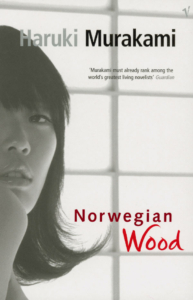A Tale for the Time Being by Ruth Ozeki
 Ozeki’s A Tale for the Time Being was shortlisted for the 2013 Booker Prize.
Ozeki’s A Tale for the Time Being was shortlisted for the 2013 Booker Prize.
It’s an intertwined story, told in alternating chapters, of two protagonists – Nao, a teenage Japanese-American girl writing a diary from a maid café in Tokyo’s Akiba (Akihabara, or “Electricity Town”), and Ruth, a resident of a remote island in the Pacific Northwest who finds Nao’s diary washed up on the beach sometime after the 2011 tsunami.
Nao’s cynical, precocious take on contemporary Japan is infectious from page one, while Ruth’s drive to research and annotate Nao’s diary propels the mystery of Nao’s fate forward.
Along the way, the two joined narratives tackle subjects including school bullying, teenage depression and suicide, reluctant World War II kamikaze pilots, 9/11, Japan’s 2011 natural disaster, and even a primer on Zen Buddhism, thanks to Nao’s eminently wise 104-year-old great-grandmother, “Old Jiko.”
The Thousand Autumns of Jacob de Zoet by David Mitchell

Literary virtuoso David Mitchell’s 1999 debut novel Ghostwritten used nine interconnected chapters to link the fates of characters in Okinawa, Tokyo, Hong Kong, Mount Emei (China), Mongolia, St. Petersburg, London, Ireland, and New York. (In Cloud Atlas, he did similar, but across the centuries.)
With The Thousand Autumns of Jacob de Zoet (2010), Mitchell narrows his scope to a historical-fiction tale of 19th century Dutch traders – the only Europeans allowed in Japan for much of the isolationist Edo era – on the island of Dejima off the shore of Nagasaki.
If that sounds bland, think again – at its heart, the novel is a love story between Jacob and the local midwife Orito, who by circumstance of her profession and studies is allowed limited contact with the foreigners.
Throw in characters like the pedantic Dr. Marinus, the devious cook Arie Grote, and the evil Shinto abbot Enomoto, and you have a Japan novel unlike any other.
The Buddha in the Attic by Julie Otsuka

Though it takes place in America, rather than Japan, Julie Otsuka’s 2011 The Buddha in the Attic is still a novel about Japan for the skill with which it renders the wrenching experience of Issei women (first-generation immigrants) in early 20th-century California – and the lives they left behind.
Thinking they are crossing the Pacific to wed successful Japanese businessmen in America, upon arrival they quickly learn their real role will be as workhorse wives for itinerant farm laborers.
Winner of the Pen Faulkner Award and a National Book Award finalist, the book’s most distinctive trait is its narrator, an omniscient “we” who conveys both the women’s collective suffering as well as various individual’s secret, shameful acts of survival.
The Buddha in the Attic culminates in America’s internment of the women and their families during World War II; the vague explanations of their fate by a local mayor in the book’s closing pages are actually phrases pulled from a post-9/11 press conference by Donald Rumsfeld.
An Artist of the Floating World by Kazuo Ishiguro

2017 Nobel-winner Kazuo Ishiguro’s 1986 An Artist of the Floating World (shortlisted for the Booker) is kind of a set-in-Japan prototype of his 1989 The Remains of the Day (won the Booker).
Here, one of Ishiguro’s trademark unreliable narrators (instead of a World War II-era British butler, we have a World War II-era Japanese artist) comes to terms, post-war, with the realization that he is now shunned for having enlisted his artistic talents in his country’s military expansion and wartime propaganda.
Ishiguro unfolds his narrator’s dawning grasp of a life and talent misspent in prose of poignant resignation.
Norwegian Wood by Haruki Murakami

Norwegian Wood is perhaps the “least Murakami” of any of the author’s books (the least surreal, the least far-ranging), but its simplicity likely accounts for its widespread appeal.
Amid 1968 university life in Tokyo, Toru Watanabe’s ambivalent path toward adulthood intersects with three women: the fragile and bereaved Naoko, the spirited Midori, and an old soul named Reiko, with whom he shares one of the novel’s classic scenes – an impromptus booze and cigarette-fueled memorial service where, with an acoustic guitar, they play 50 songs (including the Beatles’ hit of the novel’s title) in honor of a dear friend.
The novel’s long second act, Toru’s journey to see the in-patient Naoko in the snowy mountains north of Kyoto, is spellbinding.


